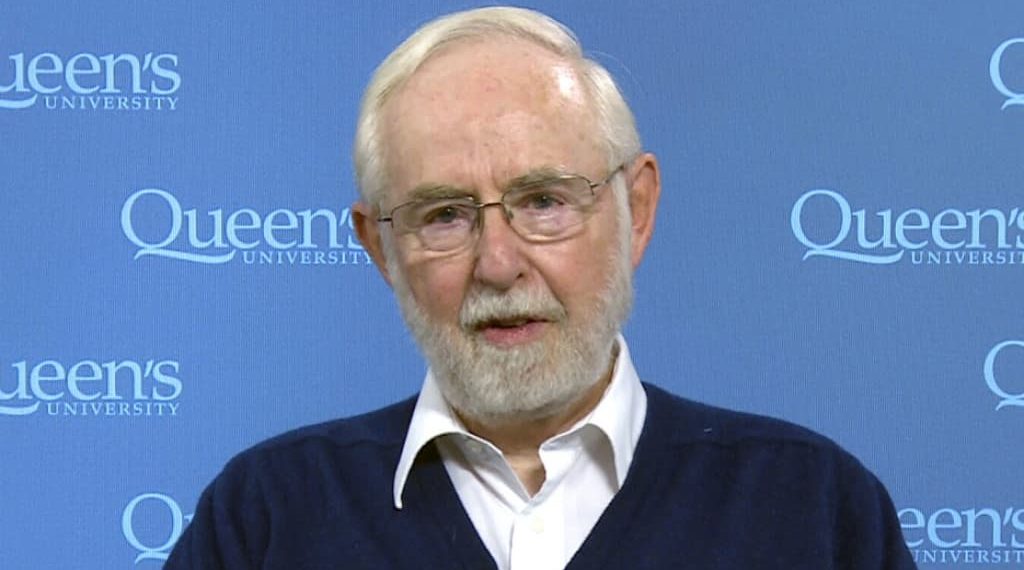Arthur Bruce McDonald was born in Sydney, Nova Scotia on August 29th of 1943 and is a Canadian astrophysicist.
He served the Sudbury Neutrino Observatory Collaboration as the director and from 2006 through 2013 he held the Kingston Queen’s University Gordon and Patricia Gray Chair in Ontario for Particle Astrophysics. In 2015, he was awarded the Nobel Prize for Physics along with Takaaki Kajita, a Japanese physicist. He began his education at Nova Scotia’s Dalhousie University. In 1964 he earned his B.Sc. in physics and in 1965 his M.Sc. in physics. He continued his education at the California Institute of Technology and in 1969 he received his Ph.D. in physics.
Arthur Bruce McDonald stated his inspirations for entering the field of physics were his physics professor during his first year at Dalhousie and his math teacher in high school. He worked just northwest of Ottawa for the Chalk River Nuclear Laboratories as a research officer from 1969 until 1982. From 1982 until 1989 he served Princeton University as a professor of physics. He left Princeton to become a professor at Queen’s University from 1989 until 2013. He went to Kingston Canada’s Queen’s University in 2013 to become Professor Emeritus. Arthur Bruce McDonald has remained active in basic research for Dark Matter and Neutrinos at the SNOLAB underground Laboratory. He additionally serves the Perimeter Institute as a member of the board for Theoretical Physics.
The question as to whether neutrons have mass has been researched and investigated by physicists since the end of the 1960’s.
These experiments have led physicists to believe neutrons may contain mass. The predictions made according to theoretical models of the sun indicate neutrinos are made in large numbers. Less neutrinos have been repeatedly observed than the number expected by neutrino detectors on the Earth. There are only three varieties of neutrinos, the tau, muon and electron neutrinos. The electron neutrinos are the most sensitive to the solar neutrino detectors. The most common explanation as time has passed is the missing neutrinos had either oscillated or changed into a type of neutrino the detectors had very little or no sensitivity for. The law of quantum mechanics states if a neutrino oscillates, it has to be a mass.
Arthur Bruce McDonald had a collaborator at the University of California at Irvine named Herb Chen.
In 1984, he spoke of the advantages of a detector using heavy water for solar neutrinos. Heavy water was different than what had been used in the past because the detector became sensitive for two additional reactions. The first reaction had a sensitivity to all neutrino flavors and the second only showed sensitivity for the electron neutrino. This type of detector was capable of directly measuring the neutrino oscillations. Arthur Bruce McDonald, Herb Chen and the other collaborators exploited this idea by forming the SNO or the Sudbury Neutrino Observatory in 1984. The SNO was created as a detector facility, was located outside Sudbury, Ontario in a mine and used 1,000 tons of heavy water underground at 2,100 m or 6,800 feet. In November of 1987, Herb Chen died of leukemia.
Arthur Bruce McDonald began leading the Sudbury Neutrino Observatory in August of 2001. Observations were reported directly suggesting the Sun’s electron neutrinos were oscillating into tau and muon neutrinos. Arthur Bruce McDonald was one of the recipients for the Benjamin Franklin Medal in Physics in 2007, the Nobel Prize in Physics in 2015 and the Fundamental Physics Prize in 2015. This was for discovering and demonstrating neutrino oscillations and the fact neutrinos have mass.





